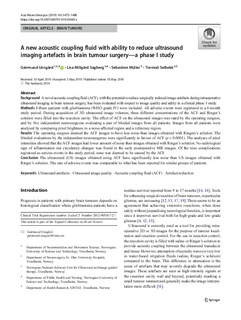| dc.contributor.author | Unsgård, Geirmund | |
| dc.contributor.author | Sagberg, Lisa Millgård | |
| dc.contributor.author | Muller, Sebastien | |
| dc.contributor.author | Selbekk, Tormod | |
| dc.date.accessioned | 2019-09-24T12:16:08Z | |
| dc.date.available | 2019-09-24T12:16:08Z | |
| dc.date.created | 2019-05-23T16:20:02Z | |
| dc.date.issued | 2019 | |
| dc.identifier.citation | Acta Neurochirurgica. 2019, 161 1475-1486. | nb_NO |
| dc.identifier.issn | 0001-6268 | |
| dc.identifier.uri | http://hdl.handle.net/11250/2618518 | |
| dc.description.abstract | Background Anovel acoustic coupling fluid (ACF), with the potential to reduce surgically induced image artefacts during intraoperative ultrasound imaging in brain tumour surgery, has been evaluated with respect to image quality and safety in a clinical phase 1 study. Methods Fifteen patients with glioblastoma (WHO grade IV) were included. All adverse events were registered in a 6-month study period. During acquisition of 3D ultrasound image volumes, three different concentrations of the ACF and Ringer’s solution were filled into the resection cavity. The effect of ACF on the ultrasound images was rated by the operating surgeon, and by five independent neurosurgeons evaluating a pair of blinded images from all patients. Images from all patients were analysed by comparing pixel brightness in a noise-affected region and a reference region. Results The operating surgeon deemed the ACF images to have less noise than images obtained with Ringers’s solution. The blinded evaluations by the independent neurosurgeons were significantly in favour of ACF (p < 0.0001). The analyses of pixel intensities showed that the ACF images had lower amount of noise than images obtained with Ringer’s solution. No radiological sign of inflammation nor circulatory changes was found in the early postoperative MR images. Of the nine complications registered as serious events in the study period, none was deemed to be caused by the ACF. Conclusion The ultrasound (US) images obtained using ACF have significantly less noise than US images obtained with Ringer’s solution. The rate of adverse events was comparable to what has been reported for similar groups of patients. | nb_NO |
| dc.language.iso | eng | nb_NO |
| dc.publisher | Springer Verlag | nb_NO |
| dc.rights | Navngivelse 4.0 Internasjonal | * |
| dc.rights.uri | http://creativecommons.org/licenses/by/4.0/deed.no | * |
| dc.title | A new acoustic coupling fluid with ability to reduce ultrasound imaging artefacts in brain tumour surgery - a phase I study | nb_NO |
| dc.type | Journal article | nb_NO |
| dc.type | Peer reviewed | nb_NO |
| dc.description.version | publishedVersion | nb_NO |
| dc.source.pagenumber | 1475-1486 | nb_NO |
| dc.source.volume | 161 | nb_NO |
| dc.source.journal | Acta Neurochirurgica | nb_NO |
| dc.identifier.doi | 10.1007/s00701-019-03945-x | |
| dc.identifier.cristin | 1699868 | |
| dc.description.localcode | © The Author(s) 2019 Open Access This article is distributed under the terms of the Creative Commons Attribution 4.0 International License (http://creativecommons.org/licenses/by/4.0/) | nb_NO |
| cristin.unitcode | 1920,16,0,0 | |
| cristin.unitcode | 1920,2,2,0 | |
| cristin.unitcode | 194,65,30,0 | |
| cristin.unitcode | 194,65,20,0 | |
| cristin.unitname | Nevroklinikken | |
| cristin.unitname | Nasjonal kompetansetjeneste for ultralyd- og bildeveiledet behandling | |
| cristin.unitname | Institutt for nevromedisin og bevegelsesvitenskap | |
| cristin.unitname | Institutt for samfunnsmedisin og sykepleie | |
| cristin.ispublished | true | |
| cristin.fulltext | original | |
| cristin.qualitycode | 1 | |

